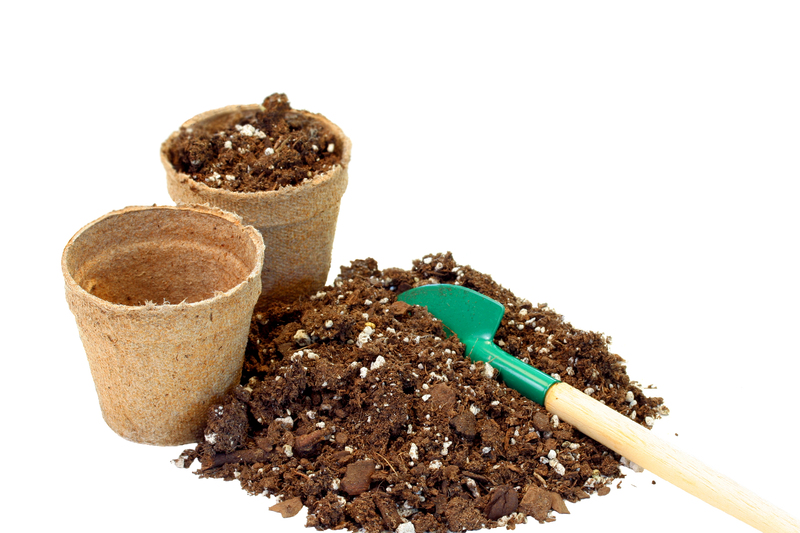Begin Your Garden Revival with These Steps
Posted on 03/07/2025
Begin Your Garden Revival with These Steps
Are you gazing out the window at a wilted patch of weeds and hoping for a colorful, inviting garden? It's never too late to transform even the most neglected outdoor space into a thriving natural paradise. If you're ready to start your garden revival, this comprehensive guide has everything you need. We'll walk you through proven strategies and actionable steps to bring your yard, patio, or balcony back to life. Whether you're a first-time gardener or looking to rejuvenate an established space, these practical garden revival tips will breathe fresh energy into your outdoor world. Happy gardening!

Why Rejuvenate Your Garden?
Before we dive into the steps for a successful garden revival, let's reflect on the benefits:
- Boost Curb Appeal: An inviting garden enhances your home's external aesthetics and overall value.
- Encourage Biodiversity: A healthy garden attracts birds, beneficial insects, and pollinators, enriching the local ecosystem.
- Promote Relaxation: Green spaces decrease stress, encourage mindfulness, and provide gorgeous spaces to unwind.
- Homegrown Produce: Fresh vegetables, herbs, and fruits from your garden improve your diet and cut grocery costs.
- Creative Outlet: Gardening is an expressive, hands-on hobby that taps into your creativity and sense of accomplishment.
Ready to restore your lackluster plot into a blooming haven? Here's how to begin your garden restoration journey step by step.
Step 1: Assess Your Existing Garden
Start with a Thorough Evaluation
To initiate your garden transformation, evaluate your current space. Identifying strengths, weaknesses, and hidden gems forms the perfect starting point for a tailored rejuvenation plan.
- Walk the Space: Observe what's thriving, what's struggling, and spots with apparent neglect or overgrowth.
- Soil Health: Perform a simple soil test using kits from local garden centers. Note areas that are dry, compacted, or overly wet.
- Sunlight Patterns: Take note of sun and shade changes throughout the day. Sun exposure determines which plants will thrive.
- Hardscape & Features: Examine fences, sheds, pathways, and patios. Are they in good shape, or do they need repair or replacement?
- Problem Areas: Identify persistent issues like weeds, pests, drainage problems, or diseased plants.
Document findings on a notepad or take photos. This thorough assessment provides a foundation for successful revival and future maintenance.
Step 2: Plan Your Garden Resurrection
Defining Your Vision
With your assessment in hand, envision how you'd ideally like your revived garden to look and function. Consider:
- Purpose: Do you want a tranquil retreat, a space for entertaining, a productive vegetable patch, or a children's play zone?
- Style: Formal, cottage, wildlife-friendly, tropical, or modern? Find inspiration in gardening magazines, online images, or local parks.
- Budget & Time: Be realistic about how much you can invest initially and seasonally.
Sketch a basic layout on paper or use garden planning apps to map paths, beds, focal points, seating, and practical zones (like compost or tool storage).
Choose Low-Maintenance Solutions
If ongoing upkeep is a concern, opt for hardy plants and low-maintenance landscaping. Consider:
- Drought-tolerant perennials & groundcovers
- Mulching to suppress weeds and retain moisture
- Drip irrigation or soaker hoses
- Raised beds or containers for easier access
Tip: Consult local gardening groups or extension services for plant recommendations suited to your region and soil type.
Step 3: Clear and Clean Up
Roll Up Your Sleeves
The actual work begins! A thorough clean-up sets the stage for transformation. Here's how to jump-start your garden revival:
- Weed Ruthlessly: Remove all weeds, invasive plants, and unwanted growth. Dig out roots to prevent regrowth.
- Prune & Deadhead: Cut back dead or diseased branches, spent flowers, and overgrown shrubs. Use sanitized pruners to avoid spreading pathogens.
- Clear Debris: Rake up fallen leaves, twigs, and litter. Dispose of plant material responsibly--consider composting where possible.
- Repair Hardscaping: Mend broken fences, clean patios, fix steps, and clear paths to ensure safety and enhance aesthetics.
This step breathes instant energy into the area and prepares your garden for new growth.
Step 4: Improve Your Soil
Feed the Roots of Revival
Healthy, nutrient-rich soil underpins every thriving garden. Don't skip this crucial step!
- Add Compost: Spread well-rotted compost or manure to boost fertility and soil structure.
- Aerate: Loosen compacted soil using a fork or aerator, especially in high-traffic areas.
- Mulch: Top beds with organic mulch (wood chips, leaves, straw) to suppress weeds and lock in moisture.
- Amend Soil: Apply lime, sulfur, or other amendments based on your earlier soil test results to balance pH and nutrients.
Tip: Healthy soil means fewer pests and diseases, stronger plants, and improved drought resistance.
Step 5: Select Plants for Your Garden's Revival
Right Plant, Right Place
With a refreshed palette before you, it's time to choose plants that will thrive for years to come. Consider:
- Climate & Microclimate: Native plants are adapted to your area and require less maintenance. Consider sun, shade, and wind exposure.
- Seasonal Interest: Mix evergreens, spring bulbs, summer perennials, and autumn foliage for year-round appeal.
- Color Schemes: Harmonize with existing structures or go bold for maximum impact.
- Wildlife Support: Choose nectar- and seed-producing plants to attract bees, butterflies, and birds.
- Edible Options: Incorporate herbs, berries, or dwarf fruit trees for beauty and bounty.
Pro-tip: Group plants by water and light needs for easier care and efficient resource use.
Step 6: Plant and Mulch
Establish for Success
Planting time! Follow the best horticultural practices to ensure your new and old plants get off to a robust start:
- Dig Proper Holes: Twice as wide as the plant's root ball, but no deeper.
- Tease Roots: Gently loosen roots if they are circling the container.
- Backfill & Water Well: Firmly backfill with enriched soil, then water thoroughly to eliminate air pockets.
- Apply Mulch: Mulch 2-3 inches deep, keeping clear of plant stems to prevent rot.
Insider tip: Overplanting can cause overcrowding and disease. Give each plant enough space to flourish.
Step 7: Water Wisely and Fertilize
Establish the Right Routine
Proper watering and fertilizing sustains your revived garden. Adapt your approach to the needs of your new and existing plantings.
- Deep Watering: Water less frequently but deeply to encourage strong root systems.
- Morning Watering: Water early in the day to minimize evaporation and fungal issues.
- Mulch for Moisture Retention: As mentioned, mulch helps conserve water and stabilize soil temperatures.
- Feed Responsibly: Use slow-release organic fertilizers according to plant needs and soil test results.
Step 8: Maintain and Monitor
Keep Your Garden in Peak Condition
Your garden revival journey continues with consistent care. Make it easier on yourself with these simple routines:
- Weed Control: Address weeds when young for easy removal and less competition.
- Deadheading: Regularly remove spent blooms to encourage continuous flowering.
- Pruning: Shape bushes and trees yearly, and remove dead material promptly.
- Pest & Disease Watch: Inspect for early signs of problems. Use eco-friendly solutions first, such as hand-picking pests or homemade sprays.
- Irrigation Checks: Repair leaks, adjust drippers, and avoid overwatering, especially later in the season.
Consistency is the key to a triumphant, lush garden, so set a weekly maintenance schedule that suits your lifestyle.
Bonus Tips: Small Garden Revitalization Quick Wins
- Brighten up with colorful containers filled with annuals or herbs if you're limited on ground space.
- Install window boxes or vertical gardens to add greenery to balconies or patios.
- Refresh tired furniture with weatherproof paint or add garden art for instant pizzazz.
- Add a water feature such as a tabletop fountain for relaxing sound and increased wildlife attraction.
Garden Revival Mistakes to Avoid
- Skipping Soil Prep: Skimping on soil health undermines all your planting efforts.
- Planting Incompatible Species: Avoid mixing sun-lovers and shade-lovers in the same bed.
- Neglecting Maintenance: Regular attention is a must to thwart weeds and pests.
- Underestimating Growth: Consider mature plant sizes to avoid future overcrowding.
- Overwatering: More plants die from excess water than drought!

Ready to Begin Your Garden Revival?
Restoring your garden isn't just about plants - it's about creating a sanctuary for you, your family, and local wildlife. With thoughtful planning, diligent preparation, and consistent care, any garden can enjoy a dramatic revival. Each of these steps brings you closer to a vibrant, welcoming outdoor space you'll love for years.
So, don your garden gloves and let your creativity take root. Let the journey of your garden revival begin today! Share your success stories and questions below; together, we'll make our neighborhoods greener, one garden at a time.
Frequently Asked Questions about Garden Revival
- How long does a full garden revival take? Depending on size and condition, it may take a few weekends for small gardens, or several months for larger or highly neglected plots.
- Is it expensive to restore a garden? While costs vary, DIY and seasonal purchases, reusing materials, and community swaps can keep expenses low.
- When is the best season to start a garden revival? Spring and early autumn offer optimal conditions for most planting and renovation projects.
Don't wait for your garden to revive itself! With clear steps to restore your outdoor space, you'll create a thriving haven that brings color, energy, and joy to your home.

